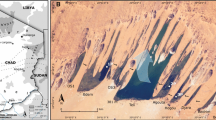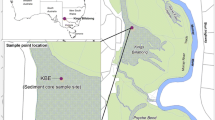Abstract
The estuary of the lower River Murray features a complex mosaic of lakes, coastal lagoons and interconnecting channels. The waters of these wetlands are degraded as a result of river regulation, water abstraction, salinisation, sedimentation and the recent constriction of the River mouth. Palaeolimnologial analysis of sediment cores in two wetlands reveals that salinity in the large terminal Lake Alexandrina was only moderately influenced by tidal inflow, particularly over the past ca. 2000 years. It is now largely fresh as a result of isolation by a series of barriers completed by 1940 AD. In contrast, the seaward portion of the Coorong, a back barrier coastal lagoon, was determined to be a subsaline estuary strongly influenced by marine inflows. These findings contrast somewhat with the Coorong’s current Ramsar classification as a saline lagoon. Riverine diatoms, typical of the fossil flora of Lake Alexandrina, are rare or absent in the Holocene sediments of the Coorong, other than for a short period in the late Holocene in the northernmost end of the lagoon. The palaeolimnological evidence for independent evolution of these wetlands is consistent with geomorphic evidence of a stranded, last interglacial shoreline that acted as a sill limiting the exchange of flows between Lake Alexandrina and the Coorong lagoon.







Similar content being viewed by others
References
Appleby, P. G. & F. Oldfield, 1992. Application of lead-210 to sedimentation studies. In: Ivanovich, M. & R. S. Harmon (eds), Uranium-series Disequilibrium: Applications to Earth, Marine and Environmental Sciences. Clarendon press, Oxford: 731–778.
Archibald, R. E. M., 1983. The Diatoms of the Sundays and Great Fish Rivers in the Eastern Cape Province of South Africa. Cramer, Vaduz.
Barnett, E., 1993. A Holocene paleoenvironmental history of Lake Alexandrina, South Australia. Journal of Paleolimnology 12: 259–268.
Battarbee, R. W., 1986. Diatom Analysis. In B.E. Berglund (ed.), Handbook of Holocene Palaeoecology and Palaleohydrology. John Wiley, Chichester.
Bennion, H., J. Fluin & P. Appleby, 2000. Palaeolimnological Investigation of Scottish Freshwater Lochs. SNIFFER Report No. SR (00)02D. ENSIS Ltd. London.
Bennion, H., J. Fluin & G. L. Simpson, 2004. Assessing eutrophication and reference conditions for Scottish freshwater lochs using subfossil diatoms. Journal of Applied Ecology 41: 124–138.
Bourman, R. P. & E. J. Barnett, 1995. Impacts of river regulation on the terminal lakes and mouth of the River Murray, South Australia. Australian Geographical Studies 33: 101–115.
Bourman, R. P. & C. V. Murray-Wallace, 1991. Holocene evolution of a sand spit at the mouth of a large river system: Sir Richard Peninsula and the Murray Mouth, South Australia. Zeitschrift fur Geomorphologie 81: 63–83.
Bourman, R. P., C. V. Murray-Wallace, A. P. Belperio & N. Harvey, 2000. Rapid coastal change in the River Murray estuary of Australia. Marine Geology 170: 141–168.
Bowler, J. M., 1981. Australian salt lakes. A palaeohydrological approach. Hydrobiologia 82: 431–444.
Cann, J. H., R. P. Bourman & E. J. Barnett, 2000. Holocene foramanifera as indicators of relative estuarine-lagoonal and oceanic influences in estuarine sediments of the River Murray, South Australia. Quaternary Research 53: 378–391.
Commonwealth of Australia and the Governments of New South Wales, Victoria, South Australia, and the Australian Capital Territory (COAG), 2004. Intergovernmental agreement on addressing water overallocation and achieving environmental objectives in the Murray-Darling Basin.
De Deckker, P., 1981. Australian salt lakes: history, chemistry and biota – a review. Hydrobiologia 105: 231–244.
Eastburn, D. 1990. The river. In Mackay N. & D. Eastburn (eds), The Murray. Murray Darling Basin Commission, Canbera: 3–16.
England, R., 1993. The Cry of the Coorong: The History of Water flows into the Coorong: From Feast to Famine? Kingston, SA: 48 pp.
Espinosa, J., 1994. Diatom palaeoecology of the Mar Chiquita Lagoon Delta, Argentina. Journal of Paleolimnology 1: 17–23.
Fluin, J., 2002. A diatom – based palaeolimnological investigation of the lower Murray River, south eastern Australia. Ph.D. thesis, School of Geographical and Environmental Studies, Monash University, Victoria.
Foged, N., 1978. Diatoms in Eastern Australia. Cramer, Vaduz.
Gasse, F., 1986. East African Diatoms: Taxonomy, Ecological Distribution. Cramer, Berlin.
Gasse, F. S., L. Juggins & B. Khelifa, 1995. Diatom-based transfer functions for inferring hydrochemical characteristics of African palaeolakes. Palaeogeography, Palaeoclimatology, Palaeoecology 117: 31–54.
Geddes, M., 1984. Limnology of Lake Alexandrina, River Murray, South Australia, and the effects of nutrients and light on the phytoplankton. Australian Journal of Marine and Freshwater Research 35: 399–415.
Gell, P. A., 1997. The development of a diatom data base for inferring lake salinity: towards a quantitative approach for reconstructing past climates. Australian Journal of Botany 45: 389–423.
Gell, P., J. Tibby, J. Fluin, P. Leahy, M. Reid, K. Adamson, S. Bulpin, A. MacGregor, P. Wallbrink, G. Hancock & G. B. Walsh, 2005. Accessing limnological change and variability using fossil diatom assemblages, south-east Australia. River Research and Applications 21: 257–269.
Germain, H., 1981. Flores des diatomées des eaux douces et saumâtres. Société Nouvelle des Editions Boubeé, Paris.
John, J., 1983. The Diatom Flora of the Swan River Estuary Western Australia, Bibliotheca Phycologia 64, J. Cramer, Vaduz.
Jones, G., T. Hillman, R. Kingsford, T. MacMahon, K. Walker, A. Arthington, J. Whittington & S. Cartwright, 2002. Independent Report of the Expert Reference Panel on Environmental Flows and Water Quality Requirements for the River Murray System. Cooperative Research Centre for Freshwater Ecology, Canberra, Australia.
Krammer, K. & H. Lange-Bertalot, 1986. Susswasserflora von Mitteleuropa. Bacillariophyceae, Teil i: Naviculaceae. Gustav Fischer Verlag, Stuttgart.
Krammer, K. & H. Lange-Bertalot, 1988. Susswasserflora von Mitteleuropa. Bacillariophyceae Teil ii: Bacillariaceae, Epithemiaceae, Surirellaceae. Gustav Fischer Verlag, Stuttgart.
Krammer, K. & H. Lange-Bertalot, 1991a. Susswasserflora von Mitteleuropa. Bacillariophyceae Teil iii: Centrales, Fragilariaceae, Eunotiaceae. Gustav Fischer Verlag, Stuttgart.
Krammer, K. & H. Lange-Bertalot, 1991b. Susswasserflora von Mitteleuropa. Bacillariophyceae Teil iv: Achnanthaceae. Gustav Fischer Verlag, Stuttgart.
Leahy, P. J., J. Tibby, A. P. Kershaw, H. Heijnis & J. S. Kershaw, 2005. The impact of European settlement on Bolin Billabong, a Yarra River floodplain lake, Melbourne, Australia. River Research and Applications 21: 131–149.
Leslie, C. & G. J. Hancock (in press). Estimating the date corresponding to the horizon of the first detection of 137Cs and 239+240Pu in sediment cores. Journal of Environmental Radioactivity (accepted).
Mackay, A. W., D. B. Ryves, R. W. Battarbee, R. J. Flower, D. Jewson, P. Rioual & M. Sturm, 2005. 1000 years of climate variability in central Asia: assessing the evidence using Lake Baikal diatom assemblages and the application of a diatom-inferred model of snow thickness. Global & Planetary Change 46: 281–297.
McCormac, F. G., A. G. Hogg, P. G. Blackwell, C. E. Buck, T. F. G. Higham & P. J. Reimer, 2004. SHCal04 Southern Hemisphere Calibration 0–11.0 cal kyr BP. Radiocarbon 46: 1087–1092.
Menzies, B., 1983. Irrigation and Settlement in the South Australian Riverland. South Australian Department of Agriculture, Adelaide.
Norris, R. H., P. Liston, N. Davies, J. Coysh, F. Dyer, S. Linke, I. Prosser & B. Young, 2002. Snapshot of the Murray-Darling Basin River Condition. Cooperative Research Centre for Freshwater Ecology, Canberra, Australia.
Ogden, R. W., 2000. Modern and historical variation in aquatic macrophyte cover of billabongs associated with catchment development. Regulated Rivers: Research & Management 16: 487–512.
Reid, M., J. Fluin, R. Ogden, J. Tibby & P. Kershaw, 2002. Long-term perspectives on human impacts on floodplain-river ecosystems, Murray-Darling Basin, Australia. Verhandlungen der Internationalen Vereinigung für Theoretische und Angewandte Limnologie. 28: 710–716.
Robbins, J. A., 1978. Geochemical and geophysical applications of radioactive lead. In Nriagu, J. O. (ed.), The Biogeochemistry of Lead in the Environment, Part A. Elsevier Scientific, Amsterdam: 285–393.
Roberts, N., 1998. The Holocene: An Environmental History, 2nd edn. Blackwell Publishers, Oxford.
Shotton, F. W., 1972. An example of hard water error in radiocarbon dating of vegetable matter. Nature, 240: 460–461.
Sim, T. & K. Muller, 2004. A Fresh History of the Lakes: Wellington to Murray Mouth, 1800s to 1935. River Murray Catchment Water Management Board, Strathalbyn.
Stanley, S. & P. De Deckker, 2002. A Holocene record of allochthonous mineral grains into an Australian alpine lake; implications for the history of climate change in southeast Australia. Journal of Paleolimnology 27: 207–219.
Stuiver, M. & P.J. Reimer, 2005. Radiocarbon calibration program CALIB rev5.0.2, http://calib.qub.ac.uk/calib/calib.html, accessed on 22.1.2007.
ter Braak, C. J. F. & P. Smilauer, 1999. Canoco for Windows Version 4.02. Wageningen, The Netherlands, Centre for Biometry, Wageningen.
Tucker, P. J., 1997. Sediment interactions between Lake Alexandrina and the Coorong: the impacts of the Murray Mouth Barrages. Unpublished Honours thesis. Department of Geography, University of Adelaide.
Weckström, K. & S. Juggins, 2006. Coastal diatom–environment relationships from the Gulf of Finland, Baltic Sea. Journal of Phycology 42: 21–35.
Witkowski, A., H. Lange-Bertalot & D. Metzeltin, 2001. Diatom Flora of Marine Coasts 1. Iconographia Diatomologica, Vol. 7. A.R.G. Gantner Verlag, Ruggell.
Acknowledgements
This project was partly funded through the National Action Plan for Salinity and Water Quality under the Upper South East Dryland Salinity and Flood Management Program (USEDS & FMP). Liz Barnett kindly provided access to LA2 sediments. Penny Everingham of the DWLBC provided administrative support. The cooperation of the Ngarrindjeri community is greatly appreciated, particularly Derek Gollin. Asta Cox, Carl Sayer, Glenn Tassicker, Angus MacGregor, Ashley Natt and Craig McVeigh assisted with fieldwork.
Author information
Authors and Affiliations
Corresponding author
Rights and permissions
About this article
Cite this article
Fluin, J., Gell, P., Haynes, D. et al. Palaeolimnological evidence for the independent evolution of neighbouring terminal lakes, the Murray Darling Basin, Australia. Hydrobiologia 591, 117–134 (2007). https://doi.org/10.1007/s10750-007-0799-y
Issue Date:
DOI: https://doi.org/10.1007/s10750-007-0799-y




